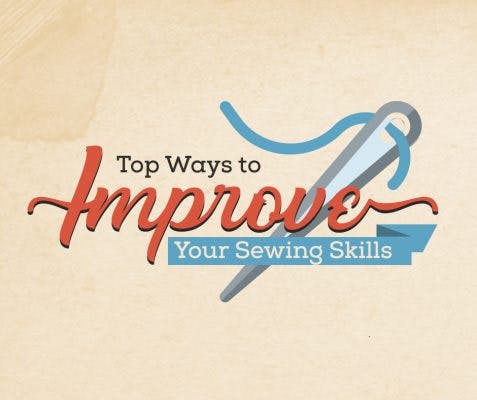It's All About the Basics
We all want to improve our skills. Some of us takes classes, practice every day, or try out as many advanced techniques as we can. When we improve our sewing skills we can create more projects and even turn our hard work into an income source.
There are a lot of things that you can do to upgrade your craft, but mastering the basics is the key skill that will make you cumulatively better at everything rather than rushing to learn as many techniques as possible.
The following core disciplines will help you in virtually every other facet of your work, particularly as you explore new skills and techniques.
Dutch Label Shop’s Top Ways to Improve Your Sewing Skills
1. Cutting Patterns Carefully
Before cutting your fabric, press your pattern paper to get rid of wrinkles that may distort the shape of the fabric you intend to cut. Be mindful if the pattern requires cutting something on the grain, which means lining up the pattern piece in the warp thread’s direction. Moreover, before cutting fabric in a particular dimension, do what woodworkers do - measure twice and cut once.
2. Measuring Seam Allowances
Seam allowance requirements are different for different stitches and projects. Even the slightest error in estimating the seam allowance can ruin an entire project. Make sure to follow seam allowance instructions on patterns closely. Continuously checking your seam allowance as you sew is never a bad idea as it may change during the course of a given project.
If you are uncertain of how wide your seam allowance should be, practice it first on a fabric scrap and mark that spot on your presser foot or sewing machine.
Finally, seam allowance has to be trimmed down after sewing. Clip around curves and corners to reduce the bulk and achieve the proper shape.
3. Pay Attention to the Details
If the directions you are following say to sew something by hand, do it by hand! These details are very important for the outcome of the project. You can use decorative stitches to highlight areas of your project or you can do your own piping for an added flair.
4. Press Fabric Properly
Pressing is different from ironing. Use the proper pressing tools and techniques for your project and set up heat according to the fabric care instructions. You can always test your pressing technique on a spare piece of fabric to make sure you are getting the right heat, especially if you’re using it for the first time. Proper pressing of fabric is a big contributor to achieving your desired outcome.
5. Make Use of Sewing Gadgets
There are several useful sewing gadgets to help you sew. Don't hesitate to use those gadgets. Examples of great tools are loop turners, a flat-felling foot, and a bias-tape maker. Also, gadgets like scissors with a measuring laser or a rotating cutting mat are indispensable for every sewing lover.
6. Make Mistakes and Learn from Them
It sounds quite obvious and applies to a lot of things in life but just a reminder that it's true for sewing as well. By making mistakes, you learn how to work with different sewing methods differently, gain more intimate knowledge of how your sewing machine works, and what you love or hate about sewing.
7. Press Seams as You Sew
Sewing is not difficult if you use some smart methods. An easy way of improving both your sewing skills and the end result is by pressing. Good pressing of your seams will make your sewing look great.
8. Choose Quality Fabric
It is tempting to buy cheap fabric, but cheap fabric commonly leads to a poorly sewn product. Low-quality fabrics are often thinner and behave strangely when you are working with them leading to all sorts of issues with the final product. Invest in good quality materials and get a great end product.
9. Watch Your Stitch Tension
When stitching, it is important to keep a close eye on the tension of your stitch. Stitching with a low tension will cause wrinkles in your threads. Also, make sure that your stitches are even. Proper stitching tension will benefit the end result.
10. Choose a Sewing Pattern Based on Your Experience
It is common for new sewists to buy patterns that are beyond their experience level which leads to frustration and in many cases negates the pleasure of sewing - which is the whole point!
The opposite also applies. Choosing a pattern that is too easy makes the task boring and feels like a chore. Try to always choose a sewing pattern based on your experience, interest, and skills. Try to avoid sewing things that you don't find interesting. There are a lot of great websites out there that categorize their patterns based on experience and skill sets. Take them seriously :)
11. Use Clothing Labels The Right Way
We know and love labels and want to make sure you do too. From branding handmade fabric items you sell to wanting to make sure your children's clothes don't get lost at summer camp, clothing labels are indispensable. If you really want to make your work stand out in a retail environment, a personalized hang tag goes a long way. If you want to know more about the best practices for designing and sewing clothing labels, we have a great guide for you filled with product tips for clothing labels and hang tags, so that your labels match your needs every time.
By observing these basic steps, you are setting yourself up for sewing skills improvement. Finally, putting custom labels for clothing on your projects makes them more professional looking.

